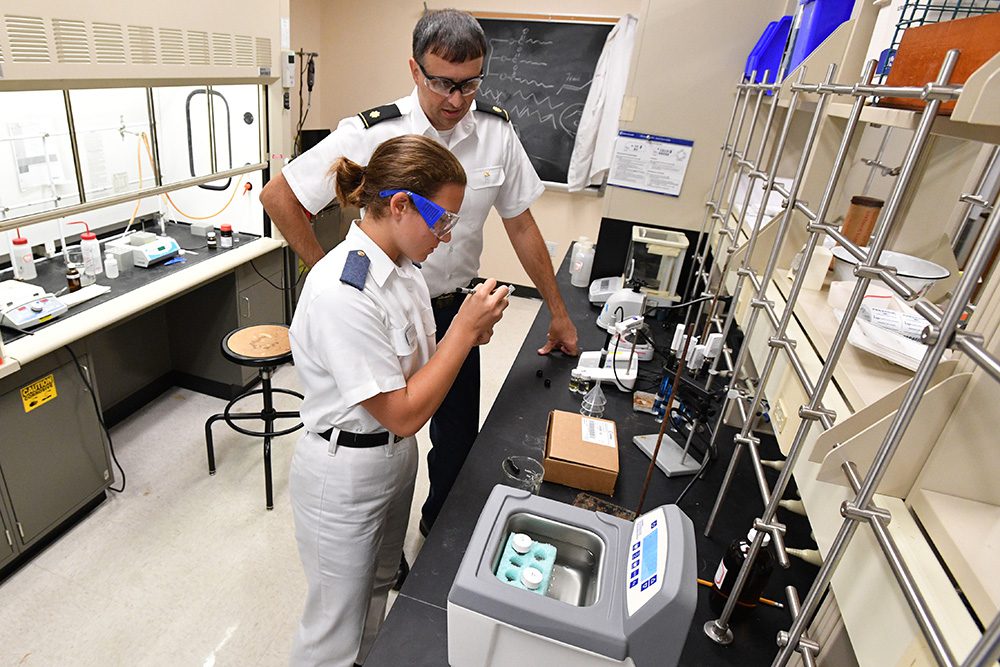Chemistry Professor Searches for Clues to Life’s Mysteries

Maj. Kevin Braun watches as Noelle Heilpern ’23 prepares a pottery sherd for analysis. VMI photo by Kelly Nye.

Maj. Kevin Braun watches as Noelle Heilpern ’23 prepares a pottery sherd for analysis. VMI photo by Kelly Nye.
“Chemistry can answer a lot of questions.” So says Maj. Kevin Braun, assistant professor of chemistry, who was still in college when he discovered that a career in chemistry could allow him to deepen his interests in archaeology, anthropology and forensics.
Now in his second year of teaching at VMI, Braun is still mixing and melding those interests as he invites cadets to share in his research, most of which centers around chemical archaeology and forensic chemistry.
One such cadet – Noelle Heilpern ’23 – is only in her 4th Class year, yet she’s working on analysis of lipid (fat and oil) residues found within archaeological pottery samples from a settlement of the Arikara, a Native American tribe that made its home in the Dakotas. Members of the tribe cultivated the “three sisters” crops of corn, squash and beans and supplemented their diets with meat from bison and other animals.
Analysis of the pots the Arikara used to cook food, Braun explained, could provide clues to learning more about their diet and how they lived – and unglazed pottery often holds residues of the fats and oils from foods the pottery once contained. The sherds, or fragments, of such pottery now line a shelf of Braun’s lab, each placed in a numbered plastic bag.
“I’m doing lipid analysis on these pottery sherds to determine what kind of materials and food products were used in [them] to see what the indigenous peoples were going to be using the pottery for, to determine what kind of fatty acids and other lipids are detected in the pottery,” said Heilpern.
Braun explained that beginning in the late 18th century, the Arikara were forced to move north into what is now North Dakota – a region with a much shorter growing season than their native South Dakota.
“The archaeologist on this project is really interested in figuring out how [the Arikara] adapted to being in a new environment,” said Braun. “It’s not clear how they adapted to being in that climate zone, so hopefully the residue analysis will be able to kind of help put some pieces together.”
The ultimate goal of the work, Braun commented, is to determine if contact with Europeans, such as Spanish traders traveling up the Missouri River, decreased the dietary diversity of the Arikara.
Heilpern noted that she’s grateful to have a chance to do independent research very early in her college career.
“I like the chemical methodology behind it,” said Heilpern. “I like learning new techniques. As a rat, I’m not very well-versed in chemistry yet, so being able to try out all of these different techniques and tools, it kind of puts me ahead of the curve.”
Braun added that he’s applied for a National Geographic Society grant that, if awarded to him, would be used to fund a trip to Peru, where he and cadets could analyze pre-Incan pots found in the Peruvian High Andes.
Also working in Braun’s lab this fall is Tom Wiltshire ’22, who is analyzing pen inks to detect possible forgeries. “My research is using a method called capillary electrophoresis to identify different types of pen inks,” said Wiltshire.
Capillary electrophoresis, explained Braun, is a way of separating molecules based on their interaction with an electrical field.
Among the many applications of this technology is the detection of forged or altered checks. Currency, said Braun, is now much harder to forge than it once was, but checks are still vulnerable to fraud.
“A lot of what we’re looking at is when someone has written a check, and then someone goes back and modifies the check,” Braun commented. “What would be a $1,000 check becomes a $9,000 check.”
For now, Braun and Wiltshire are dealing with fresh inks, but they have plans to change that strategy down the road.
“My future research is going to deal with ink degradation over time,” said Wiltshire. “A lot of past research has included perfect samples that are created in the lab. I want to test what happens if it’s exposed to sunlight or water, what happens if you carry a check around in your pocket.”
Another upcoming change has to do with including the analysis of printer inks. “Right now it’s only pen inks,” Wiltshire commented. “I’d like to transfer it to printer inks because a lot of times now we have really high-tech printers that can take high-tech pictures of bus tickets and game tickets, and they can be used as fakes.”
Wiltshire began working in Braun’s lab at the end of his 4th Class year. “From the start, I was captivated,” he said. “You see it on TV – all of these crime shows. It’s so popular on Netflix.” He added that his research gives him a lot to talk about with his mother, who works for the Department of the Treasury.
“I’m so privileged, as only a sophomore in college, to be doing such high-level research,” said Wiltshire. “It’s really giving me insight into what graduate school might be like and possibly careers in the field of chemistry.”